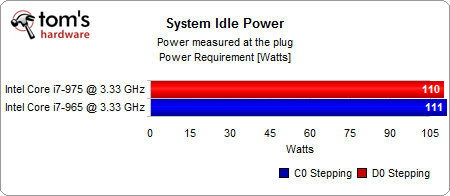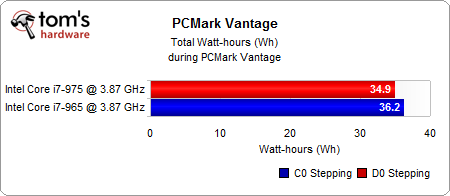Under Core i7's Hood: Comparing The C0 And D0 Steppings
Benchmark Results: Power Consumption And Efficiency
System Power Consumption

There is hardly any benefit in system idle power consumption as we go from C0 to D0 stepping. Both processors reduce their speed to 133 MHz x 15x, yielding 2.0 GHz at similar voltages. As a result, the new D0 processor only saves one watt.

The story is different at peak when Prime95 tortures the Core i7 Extreme processors. The new D0 stepping manages to deliver the same performance at a system power that is 15W lower than on the C0 processor.
Power Consumption During PCMark Vantage

As a result, the average power requirement during a full PCMark Vantage run was lower as well: 155.7W on Core i7-975 Extreme, as opposed to 161.4W on the Core i7-965.

These are the relevant results for the electricity bill: one PCMark Vantage run on our test system (see test setup) required 34.9 watt-hours (not watts per hour) on the system running the D0 processor versus 36.2 watt-hours on the older C0 stepping CPU.
Efficiency in PCMark Vantage
Get Tom's Hardware's best news and in-depth reviews, straight to your inbox.

We divided the PCMark Vantage performance score by the average power requirement in watts, which returns a nice efficiency score. In terms of performance-per-watt, the D0 stepping clearly does better than the older C0, as it delivers a slightly better performance with lower power consumption.

Check out the efficiency diagram, which shows power consumption at any given point of a PCMark Vantage run for both the C0 and the D0 test systems.
Current page: Benchmark Results: Power Consumption And Efficiency
Prev Page Benchmark Results: Audio/Video Benchmarks Next Page Conclusion